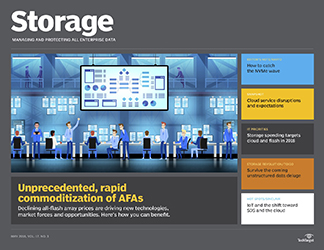PRO+ Premium Content/Storage
Access your Pro+ Content below.
IT spending priorities for 2018 include cloud and flash storage

This article is part of the Storage issue of May 2018, Vol. 17, No. 3
It's hardly news that surging data growth has put the squeeze on storage systems. To cope, organizations plan to spend heavily on cloud-based backup and the use of cloud and local flash for primary storage. Those are among the top IT spending priorities for data storage highlighted in the TechTarget 2018 IT Priorities Survey. The survey culled the results of 181 respondents in North America who identified data backup and storage as areas that dominate their time. These IT and storage pros work for organizations that maintain an average of 1.8 petabytes (PB) of capacity on premises. Twenty-one percent have 1 PB or more, including 8.5% whose storage exceeds 10 PB of capacity. Another 24% have between 250 TB and 999 TB, while 34% have between 10 TB and 249 TB. About 20% have fewer than 10 TB. Cloud storage spending to embrace backup, primary The respondents' average IT budget will increase 6% in 2018, roughly the same as 2017. Fifty-four percent of enterprise IT budgets will rise this year, with 12% expected to increase more than ...
Features in this issue
-
Three trends causing the rapid commoditization of AFA storage
Advancing technology and changing market forces have shifted the dynamics in the all-flash array market, opening it up to new challengers and benefiting customers.
-
Many enterprises aren't prepared for a cloud service outage
Some businesses have no idea what a cloud outage will cost them and who takes responsibility for restoring data and workloads, the customer or the cloud service provider.
Columns in this issue
-
NVMe technology is but a first step toward bigger things
NVMe is an inevitable move forward for flash technology that begins the transition to storage-class memory and will lead to even more significant storage advances.
-
Cohesity's hyper-converged secondary storage takes on data growth
An out-of-the-box secondary storage strategy to deal with the coming deluge of file and object data promises to overcome scalability, management and capacity limits of NAS.
